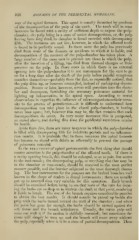Page 916 - My FlipBook
P. 916
926 DISEASES OF THE PERIDENTAL MEMBRANE.
way of the apical foramen. Tliis agent is usually furnished by products
of die decomposition of the pulp of the tooth. The tooth will in most
instances be found with a cavity of sufficient depth to expose the pulp-
chamber, the palp being in a state of active decomposition, or, the pulp
having been long dead, its chamber is found crowded with decomposing
filth. The instances are not few, however, in which the atfected tooth
is found to be perfectly sound. In these cases the pulp has previously
died from some of the diseases or accidents to which it is liable, and
decomposition of the contents of the pulp-chamber has taken place. A
large number of the cases seen in practice are those in which the pulp,
after the insertion of a filling, has died from thermal changes or from
pressure on the pulp. In those cases in which there is no external
opening into the pulp-chamber it is not uncommon for the case to go
on for a long time after the death of the pulp before painful symptoms
manifest themselves — probably from the fact, so repeatedly noticed, that
the pulp dries up, or becomes mummified, instead of undergoing decom-
position. Sooner or later, however, serum will percolate into the cham-
ber and decompose, furnishing the necessary poisonous material for
lighting up inflammation in the apical space. According to recent
observations in regard to the influence of micro-organisms—their neces-
sity to the process of putrefaction—it is difficult to understand how
decomposition can take place in the closed pulp-chamber, it having
never been open ; but, however this may be, the fact remains that such
decompositions do occur. In very many instances this is postponed,
as stated above, and during this time the peridental membrane retains
its health.
Aside from this, there are many instances in which the pulp-chamber
is- filled with decomposing filth for indefinite periods and no inflamma-
tion results. It is probable that in these instances the apical foramen
has become so closed with debris as effectually to prevent the passage
of poisonous material.
In the TREATMENT of apical pericementitis the first thing that should
receive attention is the pulp-chamber of the affected tooth. If there is
a cavity opening into it, this should be enlarged, so as to gain free access
to the root-canais ; the decomposing pulp, or anything else that may be
in the chamber or root-canals, should be removed in the most perfect
manner possible, and the interior subjected to the most thorough cleans-
ing. The best instruments for the purpose are the barbed broaches well
known in the shops of dealers in dental instruments ; these are usually
put u]) in assorted sizes very suitable for this operation. Each broach
should be examined before using, to see that none of the cuts for form-
ing t!ie barbs are so deep as to weaken the shaft at that point, rendering
it liable to break. The use of the broach requires considerable practice
to obtain the best results. It should usually be passed up beside the
pulp with the l)arbs turned toward the wall of the chamber ; and when
the point has gone far enough, the barbs should be turned against the
soft tissue and the broach withdrawn. Usually, the entire pulp will
come out with it if the motion is skilfully executed ; but sometimes the
tissue will simply be torn up and the broach will come aMay without
the pulp, especially when it is in a state of partial decomposition. Then


